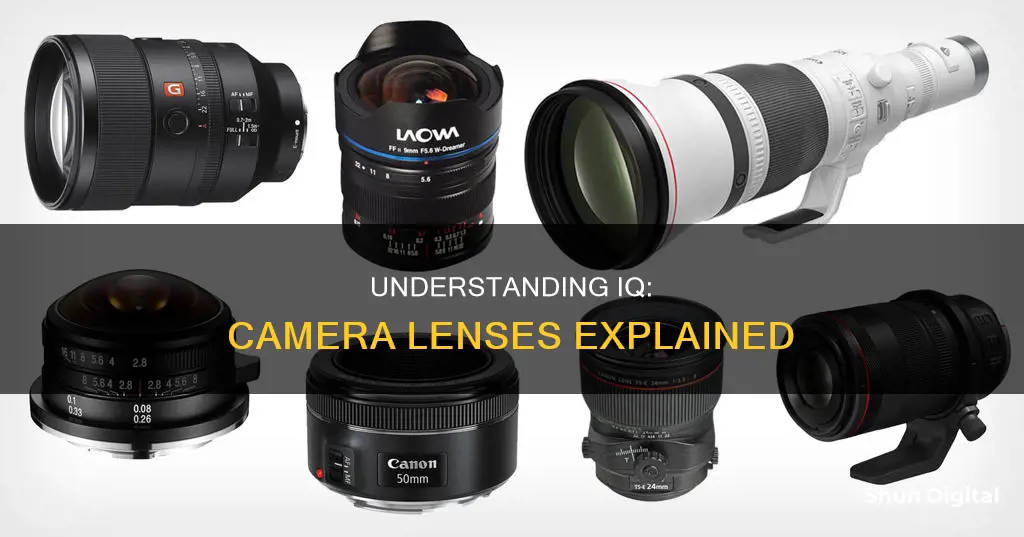
When discussing camera lenses, IQ is an acronym for Image Quality. It is a quantifiable measure of how well various digital camera sensors and lenses enable greater image quality by minimising specific physical recording constraints. Image quality is affected by several parameters, including sharpness, contrast, and colour rendition. It is also influenced by distortions and aberrations such as geometric distortion, spherical aberration, chromatic aberrations, vignetting, and flare. The recording medium also plays a role in image quality, as the performance of the lens and camera sensor are interdependent.
What You'll Learn

Image Quality (IQ)
In photography, IQ is an acronym for "Image Quality". It refers to the quality of an image delivered by a camera lens and is affected by several parameters, including sharpness, contrast, and colour rendition.
Image quality is a property of the camera and lens at a certain setting. Using a different ISO, shutter speed, image parameters (JPEG), aperture or focal length can result in different image quality from the same camera and lens combination.
There are a number of technical features in cameras and lenses that contribute to overall image quality, including image stabilisation, resolution, noise generation, dynamic range, colour accuracy, colour gamut, and sensor uniformity.
Image quality is often used by serious photographers to define the characteristics of what goes into producing great classic photographic images. It relates to equipment rather than concept or technique.
Unlocking the Secrets of Commercial Camera Lenses' Diffraction Limits
You may want to see also

Sharpness
When discussing camera lenses, IQ refers to image quality. While many people equate IQ with sharpness, it is important to note that sharpness is only one characteristic of IQ and has multiple meanings.
The sharpness of a lens can vary depending on various factors such as the aperture, focal length, and the centre or corners of the image frame. Prime lenses typically achieve the best resolution at apertures between f/2.8 and f/8, while lenses with a wide zoom range may show significant differences in sharpness at different focal lengths. Additionally, higher-resolution sensors can result in an increase in perceived sharpness but may also magnify any aberrations present.
It is worth noting that some lens aberrations and distortions, such as chromatic aberrations and vignetting, can be corrected through software or post-processing. However, these corrections may result in a loss of sharpness in the affected areas.
Overall, while sharpness is an important aspect of image quality, it is not the sole determinant. Other factors, such as contrast, colour rendition, and lighting conditions, also play a significant role in the overall IQ of an image.
Drying Camera Lenses: Quick and Easy Steps for Photographers
You may want to see also

Resolution
The resolution of a lens also depends on its design and the camera sensor it's paired with. Lenses need to be designed to fully exploit the resolution capabilities of the sensor. Additionally, higher-resolution sensors often require higher-resolution lenses to capture their full potential.
When discussing IQ, it's worth noting that while resolution is important, it's not the only factor. Other aspects such as dynamic range, colour accuracy, noise generation, and lens aberrations also play a significant role in the overall IQ of a camera and lens system.
Recycling Camera Lenses: A Guide to Sustainable Photography
You may want to see also

Dynamic Range
In photography, dynamic range is essential because it determines how well a camera can capture the full range of light intensities in a scene. The dynamic range of a camera sensor is limited by its ability to detect light, with higher-quality sensors capable of capturing a wider range of tones. On average, high-quality digital cameras can capture between 12 and 15 stops of dynamic range at a base ISO of 100, but this depends on lighting conditions and can be affected by adjustments to camera settings.
The dynamic range of a camera is important to consider when purchasing a new one. Cameras with a higher dynamic range tend to be more expensive but are better suited for capturing scenes with high contrast between lights and darks, such as sunsets and sunrises. Conversely, photographers who primarily shoot scenes with less contrast can opt for cameras with a lower dynamic range.
To maximise the dynamic range of your camera, it is recommended to keep the ISO as low as possible, as increasing the ISO reduces dynamic range. Additionally, using a wider aperture or a slower shutter speed can help achieve the desired exposure without sacrificing dynamic range.
Understanding the histogram on your camera is also crucial for managing dynamic range. The histogram represents the range of brightness in an image, and by ensuring that it stays within certain boundaries, you can optimise the camera's dynamic range.
Autofocus: Lens vs Camera, Who's the Real Hero?
You may want to see also

Color Accuracy
When discussing camera lenses, IQ stands for "Image Quality". It refers to the quality of an image delivered by the lens and is affected by several parameters, including sharpness, contrast, and color rendition.
There are several factors that influence color accuracy in camera lenses:
- White balance: This is a camera setting that establishes the true color of white, creating a baseline for measuring other colors.
- Saturation: Saturation refers to the intensity or vividness of colors in an image. It is important to control saturation to avoid unnatural color representations that can impact overall accuracy.
- Color gamut: The color gamut of a camera refers to the range of colors it can reproduce. A wider color gamut allows for a more accurate representation of a broader spectrum of colors.
- Color space and profiles: Understanding and adhering to industry-standard color spaces and profiles ensure consistency and compatibility across different devices and applications.
- Sensor characteristics: The characteristics of the image sensor, such as its spectral sensitivity and noise levels, can impact how well it captures and reproduces colors in different lighting conditions.
- Lens quality: High-quality lenses help maintain color accuracy by minimizing distortions and ensuring proper light transmission onto the image sensor.
- Lighting conditions: Different light sources have distinct color temperatures, and variations in lighting can introduce color casts, affecting color accuracy.
- Calibration and profiling: Regular calibration of cameras is necessary to ensure consistent color accuracy over time.
- Image processing algorithms: Careful consideration of image processing algorithms and their parameters is needed to avoid introducing artifacts or distortions that can affect color accuracy.
In summary, color accuracy is a critical aspect of image quality in camera lenses, and it can be improved by considering and optimizing various factors, including white balance, saturation, color gamut, sensor characteristics, lens quality, lighting conditions, calibration, and image processing algorithms.
Understanding Haze: Camera Lenses and Their Clarity
You may want to see also
Frequently asked questions
IQ stands for "Image Quality".
Characteristics of IQ include sharpness, contrast, colour rendition, geometric distortion, chromatic aberration, vignetting, flare, and more.
A number of factors affect IQ, including the lens, camera, recording medium, post-processing software, and more.
The lens can impact sharpness, resolution, focusing speed, vignetting, chromatic aberrations, and other aspects of IQ.
To improve IQ, consider using a tripod, a lens hood, or post-processing software to correct for distortions and aberrations.







